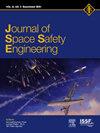Sub-cm space debris in LEO: A comparison between the ESA MASTER model and ADLER in-situ data
IF 1.7
Q3 ENGINEERING, AEROSPACE
引用次数: 0
Abstract
Modeling the Space debris and Meteoroid (SD/M) environment in Low Earth orbit is particularly challenging when it comes to sub-cm sized particles that are below the detection thresholds of ground based observations. The MASTER model of ESA is used to establish a reference for risk assessments and mission planning. However, given the significant increase in satellite operations in the last decade, the lack of recent in-situ data for calibrating the models is evident. The ADLER-1 mission, operating for 512 days at an altitude of 480 km, was an in-orbit demonstrator for deploying a piezoelectric sensor array as well as a continuous wave miniature radar to obtain pilot data. The APID-1 instrument onboard ADLER-1 yielded 117 impact events for a period of ca 400 days, which were compared to the MASTER simulations. There is evidence for detecting debris from a rocket motor firing of an ISS supply flight.
近地轨道亚厘米空间碎片:ESA MASTER模型与ADLER原位数据的比较
当涉及到低于地面观测检测阈值的亚厘米大小的颗粒时,对低地球轨道上的空间碎片和流星体(SD/M)环境进行建模尤其具有挑战性。欧空局的MASTER模型用于建立风险评估和任务规划的参考。然而,鉴于过去十年卫星业务的显著增加,显然缺乏用于校准模式的最新现场数据。ADLER-1任务在480公里的高度运行了512天,是部署压电传感器阵列和连续波微型雷达以获取飞行员数据的在轨演示。ADLER-1上的APID-1仪器在大约400天的时间里产生了117次撞击事件,与MASTER模拟结果进行了比较。有证据表明,在国际空间站补给飞行中发现了火箭发动机发射的碎片。
本文章由计算机程序翻译,如有差异,请以英文原文为准。
求助全文
约1分钟内获得全文
求助全文
来源期刊

Journal of Space Safety Engineering
Engineering-Safety, Risk, Reliability and Quality
CiteScore
2.50
自引率
0.00%
发文量
80
 求助内容:
求助内容: 应助结果提醒方式:
应助结果提醒方式:


